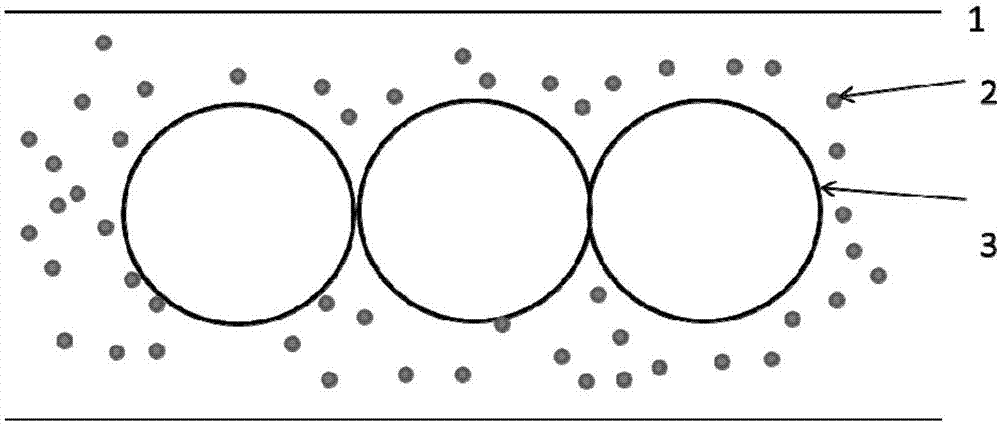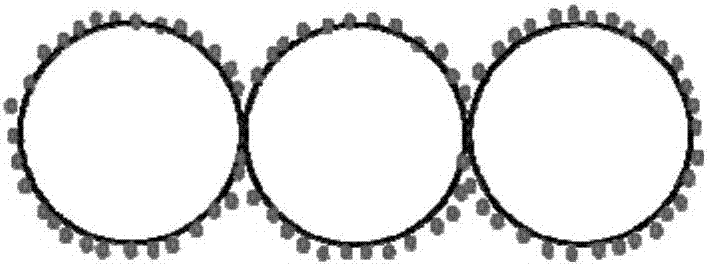Processing method for enhancing water resistance and oil resistance of cellulosic fiber fabric
A cellulose fiber, waterproof and oil-proof technology, applied in the direction of fiber treatment, plant fiber, repelling fiber to liquid, etc., can solve the problem of insufficient waterproof and oil-proof performance, and achieve good waterproof and oil-proof effect, bright color, long-lasting good effect
- Summary
- Abstract
- Description
- Claims
- Application Information
AI Technical Summary
Problems solved by technology
Method used
Image
Examples
Embodiment 1
[0032] Fabric specification: 105” / 40s*40s / 144*76, cotton satin
[0033] The fabric goes through the following conventional processes: singeing (two fronts and two reverses) → desizing → scouring → bleaching → tentering → mercerizing → whitening → printing → steaming → washing → waterproof and oil-proof finishing → calendering → preshrinking → finished product. After the fabric is processed through the above process, it can obtain better waterproof and oil-proof effect.
[0034] Among them, in the printing process, the printing paste prescription:
[0035] 0.1 part of magnesium chloride; 0.5 part of fatty alcohol polyoxyethylene ether sulfonate (3EO); 8 parts of reactive red 3BS; 2.5 parts of sodium alginate; 1.5 parts of sodium bicarbonate; 6 parts of urea; water; 100 parts total.
[0036] After the fabric is printed, the fabric is steamed and washed, and the washed fabric is waterproof and oil-proof. The waterproof and oil-proof finishing process and working fluid prescript...
Embodiment 2
[0040] Fabric specification: 105” / 40s*40s / 133*72, cotton twill
[0041] The fabric goes through the following conventional processes: singeing (two fronts and two reverses) → desizing → scouring → bleaching → tentering → mercerizing → whitening → printing → steaming → washing → waterproof and oil-proof finishing → calendering → preshrinking → finished product. After the fabric is processed through the above process, it can obtain better waterproof and oil-proof effect.
[0042] Among them, in the printing process, the printing paste prescription:
[0043] 0.05 parts of calcium chloride; 0.1 parts of magnesium chloride; 0.8 parts of fatty alcohol polyoxyethylene ether sulfonate (3EO); 12 parts of reactive red 3BS, 3 parts of sodium alginate; 2 parts of sodium bicarbonate; parts; the balance is water; a total of 100 parts.
[0044] After the fabric is printed, the fabric is steamed and washed, and the washed fabric is waterproof and oil-proof. The waterproof and oil-proof fini...
Embodiment 3
[0048] Fabric specification: 105” / 60s*60s / 200*100, cotton satin
[0049] The fabric goes through the following conventional processes: singeing (two fronts and two reverses) → desizing → scouring → bleaching → tentering → mercerizing → whitening → printing → steaming → washing → waterproof and oil-proof finishing → calendering → preshrinking → finished product. After the fabric is processed through the above process, it can obtain better waterproof and oil-proof effect.
[0050] Among them, in the printing process, the printing paste prescription:
[0051] 0.02 parts of calcium chloride, 0.04 parts of zinc chloride; 0.3 parts of fatty alcohol polyoxyethylene ether sulfonate (3EO); 5 parts of reactive red 3BS; 2 parts of sodium alginate; 1 part of sodium bicarbonate; 5 parts of urea; anti-reduction 0.5 part of agent; the balance is water; a total of 100 parts.
[0052] After the fabric is printed, the fabric is steamed and washed, and the washed fabric is waterproof and oil-p...
PUM
 Login to view more
Login to view more Abstract
Description
Claims
Application Information
 Login to view more
Login to view more - R&D Engineer
- R&D Manager
- IP Professional
- Industry Leading Data Capabilities
- Powerful AI technology
- Patent DNA Extraction
Browse by: Latest US Patents, China's latest patents, Technical Efficacy Thesaurus, Application Domain, Technology Topic.
© 2024 PatSnap. All rights reserved.Legal|Privacy policy|Modern Slavery Act Transparency Statement|Sitemap



